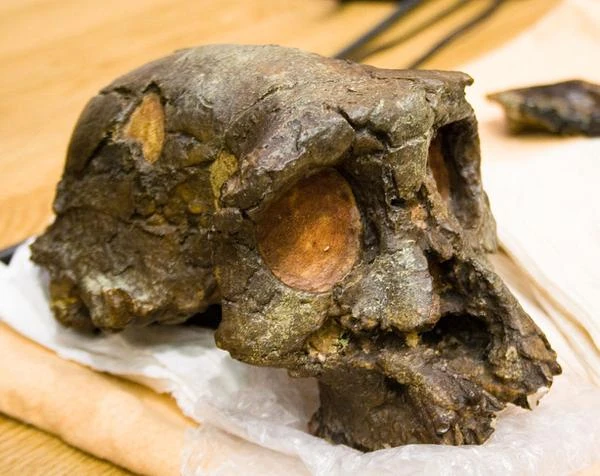
The fossil of Toumaï (Sahelanthropus tchadensis) was discovered in 2001 in the Chad Desert by the team led by Michel Brunet (1940-2021). Dated to about 7 million years ago, this skull is one of the oldest known hominins and provides key insights into the divergence between chimpanzees and hominins.
The divergence between chimpanzees and hominins is estimated at about 6 to 7 million years ago. This separation implies that some morphological and locomotor traits observed in Toumaï may represent an intermediate stage between great apes and early hominins. The study of Toumaï notably shows a more advanced position of the foramen magnum, suggesting partially bipedal locomotion.
N.B.:
The foramen magnum is the occipital opening of the skull through which the spinal cord passes. Its position and orientation help estimate posture and mode of locomotion. In quadrupedal primates, it is located posteriorly, while in bipedal hominins, it is more advanced under the skull, indicating that the head is carried above the spine. Fossils like Toumaï have an advanced foramen magnum, suggesting partial bipedalism.
| Species | Estimated Age | Key Feature | Comment and Discoverer |
|---|---|---|---|
| Sahelanthropus tchadensis (Toumaï) | ≈ 7 Ma | Advanced foramen magnum, reduced canines | Indicates partial or occasional bipedalism. Michel Brunet (1940-2021) |
| Orrorin tugenensis | ≈ 6 Ma | Femur indicating partial bipedalism | Shows mixed locomotor adaptations. Martin Pickford (1943- ) |
| Ardipithecus ramidus | ≈ 4.4 Ma | Combination of bipedalism and arboreal climbing | Intermediate lifestyle between trees and ground. Tim White (1950- ) |
| Australopithecus anamensis | ≈ 4.2-3.9 Ma | Confirmed bipedalism, robust teeth | Gradual transition to full bipedalism. Meave Leakey (1942- ) |
| Australopithecus afarensis | ≈ 3.7-3 Ma | Confirmed bipedalism, marked sexual dimorphism | Famous example: Lucy. Donald Johanson (1943- ) |
| Australopithecus africanus (Lucy) | ≈ 3-2 Ma | Rounder skull, mixed dentition | Shows advanced bipedal locomotion. Raymond Dart (1893-1988) |
| Paranthropus boisei | ≈ 2.3-1.2 Ma | Massive jaws, large molars | Adapted to a specialized diet. Mary Leakey (1913-1996) |
| Homo habilis | ≈ 2.4-1.4 Ma | Increased cranial capacity, lithic tools | First tools attributed to the species. Louis Leakey (1903-1972) |
| Homo erectus | ≈ 1.9 Ma-110 ka | Complete bipedalism, mastery of fire | Migration out of Africa and advanced behavior. Eugène Dubois (1858-1940) |
| Homo sapiens | ≈ 300,000 years – present | High cranial capacity, complex culture, developed language | Our current species. Discoverer: Johann Friedrich Blumenbach (1752-1840), first to classify Homo sapiens |
Source: Nature – Sahelanthropus tchadensis and Science Magazine.